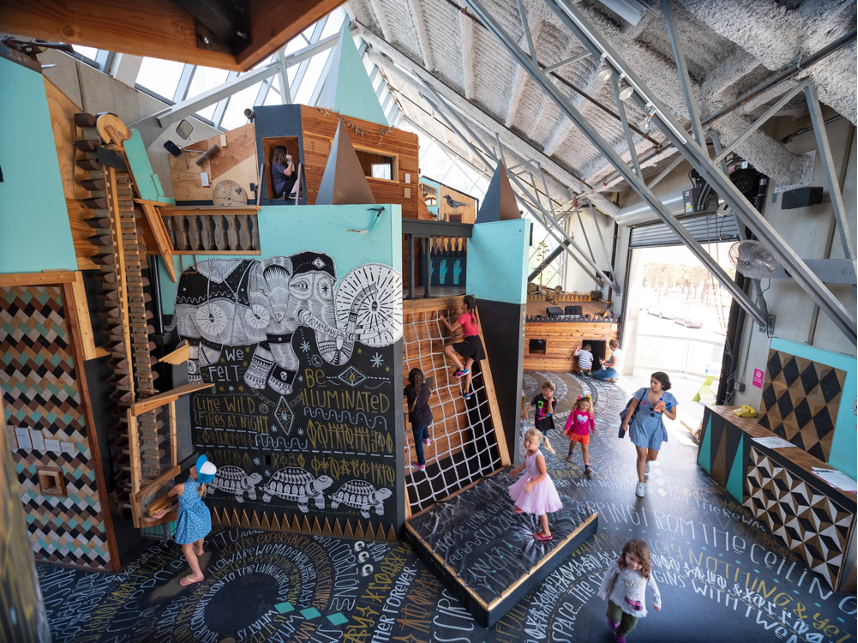
Hello! I am Patti Saraniero, an independent evaluator based in San Diego, California, specializing in evaluation in the arts and culture sector. Like a lot of folks, I have spent time in the last year cleaning out drawers and closets. One of my cleaning bursts led me to revisit video data from an evaluation project in 2015!
For the last seven years, I have worked with the New Children’s Museum, a contemporary art museum that serves children and their families in the San Diego and Tijuana, Mexico region. In 2015 we conducted an evaluation of a then-new exhibition, The Wonder Sound. To better understand children’s experience in the exhibition, we asked visitors ages 12 and younger to wear Go-Pros as they climbed, crawled, and explored the exhibition space. As I peeked back to the pre-pandemic busyness of the museum, the video was breathtaking and hard to watch at the same time.

Like many museums in California, The New Children’s Museum has been closed to the public since March 2020. Before and during the pandemic, the museum has worked hard to support resilience, which is, simply put, the ability to recover from setbacks or trauma. As communities begin to reopen and recover from the covid-19 pandemic, children will also need places to recover.
Lessons To Be Learned:
- Megan Dickerson, the museum’s Director of Exhibits, and I have started a conversation about what resilience in children could look like when they visit the museum as it reopens. We have turned back to The Wonder Sound evaluation, reexamining our findings and discussing what they offer the museum today.
- We recognize that the 2015 video data is from a very different context, an important consideration when revisiting and reanalyzing data. But it reminds us of what was as we think about what will be.
- Drawing on this data set, Megan and I will spend this winter putting together a tool to help us better understand how the museum’s exhibitions support children’s resilience and play. It is our hope that through this work we can develop greater insight into the role museums can play in supporting children and their families.
Rad Resources:
- There is a significant body of scholarship around resilience. I was struck by Skinner and Pitzer’s article about ‘everyday resilience,’ where children face and bounce back from everyday challenges.
- Wästerfors, Åkerström, and Jacobsson’s chapter, “Reanalysis of Qualitative Data” offers a thoughtful guide to revisiting and re-analyzing qualitative data.
The American Evaluation Association is celebrating Arts, Culture, and Museums (ACM) TIG Week. The contributions all week come from ACM TIG members. Do you have questions, concerns, kudos, or content to extend this aea365 contribution? Please add them in the comments section for this post on the aea365 webpage so that we may enrich our community of practice. Would you like to submit an aea365 Tip? Please send a note of interest to aea365@eval.org. aea365 is sponsored by the American Evaluation Association and provides a Tip-a-Day by and for evaluators.

Hello Patti!
As a parent of a young inquisitive daughter, and an educator, your post was one that stood out to me and made me realise how close to home and relevant evaluation can be, especially as we consider how things ‘were’ before the pandemic and how they might look in a post pandemic world.
I was interested by the idea that you are revisiting qualitative data collected before the pandemic to provide new insights into how the museum space could become a place children can ‘recover’ from the pandemic. As a high school teacher, I certainly view schools in the same way, our youth need places they can come once we return to a new normal where they can feel safe and rediscover their ‘resilience’. I found myself pondering how I too, can look at previous qualitative data like lesson plans, observation notes, students surveys etc. and use these to build a stronger foundation for the return of vulnerable young people re-entering our classrooms. Your statement about reanalysing old findings can “remind us of what was as we think about what will be” is something I look forward to exploring as I transition back into face-to-face teaching. After reading this post I am left excited about what I can learn about the classroom I ran pre-pandemic and what I can do to make changes to support my students in a time of need as they re-enter an old but new ‘norm’. Thanks for sharing your insights, it is truly a time for us to reflect and learn to ensure we rebuild and support our youth!
Best, Kate